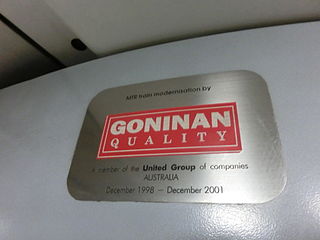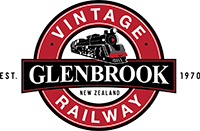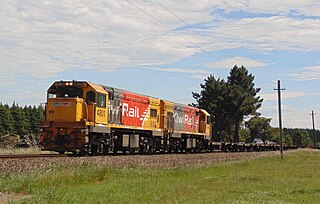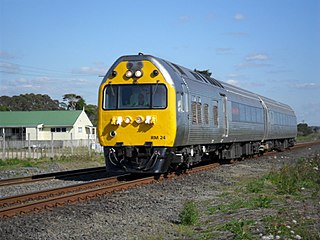
Rail transport in New Zealand is an integral part of New Zealand's transport network, with a nationwide network of 4,375.5 km (2,718.8 mi) of track linking most major cities in the North and South Islands, connected by inter-island rail and road ferries. Rail transport in New Zealand has a particular focus on bulk freight exports and imports, with 19 million net tonnes moved by rail annually, and 99.5% of New Zealand's exports and imports being transported through the country's seaports.

The North Island Main Trunk (NIMT) is the main railway line in the North Island of New Zealand, connecting the capital city Wellington with the country's largest city, Auckland. The line is 682 kilometres (424 mi) long, built to the New Zealand rail gauge of 1,067 mm and serves the large cities of Palmerston North and Hamilton.
Transdev Auckland, formerly Veolia Transport Auckland, and Connex Auckland was a subsidiary of Transdev Australasia that ran Auckland's urban passenger trains under contract from Auckland Transport on infrastructure owned and managed by KiwiRail. Auckland Transport receives funding to subsidise these services from the NZ Transport Agency, which receives funding from road user taxes and Crown appropriations, and from the Auckland Council through rates.

UGL Rail is an Australian rail company specialising in building, maintaining and refurbishing diesel locomotives, diesel and electric multiple units and freight wagons. It is a subsidiary of UGL Limited and is based in Melbourne, with a staff of 1,200 across Australia and Asia. It operates factories in Broadmeadow, Maintrain Auburn, Spotswood and Bassendean. While it used to operate a factory in Taree, the plant was shut down and the equipment sold off.

Papakura railway station is a railway station in Papakura, New Zealand, on the Southern Line of the Auckland railway network.

Pukekohe railway station is a temporarily closed railway station in Pukekohe, New Zealand. It is the southern terminus of the Southern Line of the Auckland railway network. The station has an island platform between the main lines and an original wooden station building complete with signal panel.
The Railway Enthusiasts Society Incorporated is a New Zealand railway enthusiast society formed on 17 July 1958. RES formed the Glenbrook Vintage Railway (GVR) in 1968, with GVR now forming a separate charitable trust.

The Glenbrook Vintage Railway (GVR) is a heritage steam railway in Glenbrook, New Zealand.

The New Zealand DC class locomotive is a type of diesel-electric mainline locomotive on the New Zealand rail network, operated by KiwiRail on freight trains, and formerly on long-distance passenger trains. The class was rebuilt from the DA class in the late 1970s and early 1980s, mainly in Australia. After the DA class, they were the most numerous class of diesel locomotive on New Zealand's railway network and remained numerically dominant until the mid-2010s when withdrawals began.

The New Zealand DA class locomotive were a class of diesel-electric mainline locomotives operated on the New Zealand railway system between 1955 and 1989. Consisting of 146 locomotives, it was the most numerous class to ever operate in New Zealand, with five more than the AB class steam locomotive.

The New Zealand DB class and DBR class locomotive is a type of diesel-electric locomotive built for service on New Zealand's rail network. They were built by General Motors Diesel (GMD) of Canada as a narrow-gauge version of the EMD G8 model, with seventeen locomotives constructed. Ten of these were later rebuilt into the DBR class.

The New Zealand DE class locomotive is a New Zealand class of shunting diesel-electric locomotives. The New Zealand Railways intended to replace steam locomotives for shunting duties with this class. They are physically similar to the Tasmanian Government Railways X class, which were also of English Electric design.

The ADK class are a class of diesel multiple units that were previously operated by Western Australian Government Railways (WAGR) in Perth, and later Transdev Auckland on Auckland's suburban rail network, and are currently operated by MetroBus in Maputo, Mozambique. Originally built by Commonwealth Engineering and the Midland Railway Workshops for WAGR in the late 1960s, all but one were sold in 1993 to New Zealand Rail, and were then owned by Auckland Transport. The units were completely withdrawn from service in New Zealand on 5 December 2014, following completion of electrification of Auckland's network.

The RM class was the classification used by the New Zealand Railways Department (NZR) and its successors gave to most railcars and railbuses that have operated on New Zealand's national rail network. "RM" stands for Rail Motor which was the common name at the turn of the 20th century for what became known in New Zealand as railcars. As many types of railcars are operated, class names have been given to each railcar type to differentiate them from others.
The Southern Line in Auckland, New Zealand is the name given to suburban train services that operate between Britomart Transport Centre in central Auckland and Pukekohe via Newmarket.

Auckland railway electrification occurred in phases as part of investment in a new infrastructure for Auckland's urban railway network. Electrification of the network had been proposed for several decades. Installation started in the late 2000s after funds were approved from a combination of regional and central government budgets.

The New Zealand British Rail Mark 2 carriages were built by British Rail Engineering Limited for British Rail in the early 1970s. From the mid-1990s, 150 were exported to New Zealand. After being rebuilt, refurbished and re-gauged, they entered service with a variety of operators on New Zealand's railway network. The carriages generally replaced older NZR 56-foot carriages, some of which had been in use for almost 70 years.

The New Zealand AM class of electric multiple unit (EMU) was constructed for the electrification of Auckland's railway network. The class was introduced in 2014 with the first unit having arrived in September 2013. The units are classified AM, with the driving motor car with pantograph classified AMP, the middle trailer car AMT and the driving motor car without pantograph AMA. The trains are operated by Auckland One Rail for Auckland Transport under the AT Metro brand.
The Ferrymead 125 celebration was an event to celebrate 125 years of Rail transport in New Zealand. The event was held over a week from 17 to 24 October 1988, with trains running in, and to and from Christchurch.
Railway electrification in New Zealand consists of three separate electric systems, all on the North Island. Electrification was initially adopted by the New Zealand Railways for long tunnels; the Otira Tunnel, the Lyttelton Rail Tunnel and the two Tawa Tunnels of the Tawa Flat Deviation. Electrification of Wellington suburban services started with the Johnsonville Line and Kapiti Line out of Wellington from the 1930s. Auckland suburban services were electrified in 2014–2015. Electrification of long-distance services on the North Island Main Trunk (NIMT) dates from 1986. New long tunnels, for example the Rimutaka Tunnel and the Kaimai Tunnel, were operated by diesels, and the Otira and Lyttelton Tunnels have converted to diesel operation.
















